

Thursday, March 20, 2025
Kevin Anderson
Agile Software Development: A Comprehensive Guide for Modern Teams
Agile software development changed the way teams build, test, and deliver digital products. By focusing on iterative progress, continuous feedback, and tight collaboration, Agile empowers organizations to adapt swiftly and consistently create value.
This in-depth guide explains what Agile software development is, how it works, and why it has become the standard approach in many modern development environments. We’ll explore the Agile software development lifecycle, its key tools, common questions like “why is quality assurance crucial?” and “what is a PR in software development?”, and how to integrate these concepts into your process—whether you’re a new Agile software development company or a seasoned enterprise looking to refine your methods.
Table of Contents
- Understanding Agile Software Development
- What Is Agile Software Development?
- Why Agile vs. Traditional Waterfall?
- Agile Software Development Lifecycle
- Key Agile Methodologies
- Tools Used in Agile Software Development
- The Role of Quality Assurance and Testing
- Integrating QA in Agile
- Overcoming Common Agile Challenges
- How to Learn Software Development
- What Is POC in Software Development?
- Collaboration and Communication in Agile Teams
- What Is PR in Software Development?
- Aligning Stakeholders with Iterative Feedback
- Outsourcing and Distributed Agile Teams
- FAQs About Agile and DevOps
- Taking Agile to the Next Level
- Emphasizing Continuous Improvement
- Conclusion
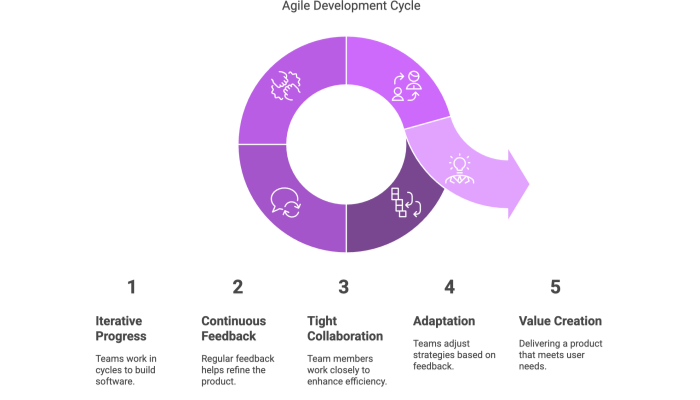

Understanding Agile Software Development
Agile software development refers to a group of methodologies designed around iterative and incremental development. Instead of planning months or years in advance (the “waterfall” approach), teams work in smaller cycles—often called Sprints—where they plan, build, and review a workable product increment. This approach allows changes to be integrated more easily as new information arises, reflecting real user feedback or shifting business priorities. The flexibility and responsiveness of Agile empower teams to make informed adjustments on the fly, which is crucial in today’s rapidly changing digital landscape.
In practical terms, Agile replaces the rigid, linear process with a more fluid framework where development, testing, and review occur simultaneously in repeated cycles. This enables teams to identify issues at an early stage, adjust their strategies quickly, and deliver a product that is more in tune with the evolving needs of customers and stakeholders. The emphasis on collaboration and transparency throughout the process helps to minimize risks and fosters a culture of continuous improvement. As a result, Agile not only accelerates time to market but also enhances the overall quality of the final product by incorporating regular user feedback.
The iterative nature of Agile creates a learning environment where each sprint builds on the success and lessons of the previous one. This dynamic process encourages teams to innovate continuously, explore creative solutions, and maintain a high level of adaptability even when faced with unexpected challenges or changing requirements.
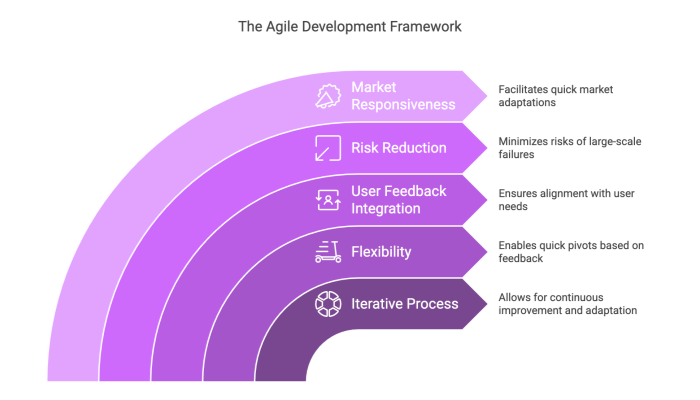

What Is Agile Software Development?
Agile is a philosophy that emerged from the Manifesto for Agile Software Development. It emphasizes the importance of individuals and interactions over strict processes, working software over exhaustive documentation, customer collaboration over contract negotiation, and the ability to respond to change rather than strictly following a predetermined plan. These core values form the backbone of Agile methodologies and encourage teams to remain flexible and responsive.
Various frameworks have been developed to put Agile principles into practice. Scrum, Kanban, and Extreme Programming (XP) are among the most well-known. Each of these frameworks provides its own set of practices, roles, and rituals designed to support iterative development and continuous improvement. The emphasis is always on delivering a functional product increment, gathering feedback, and then using that feedback to inform the next iteration. This process ensures that the product remains aligned with the customer’s evolving needs and market trends.
By focusing on rapid delivery and constant feedback, Agile enables teams to learn quickly from each iteration, leading to higher quality and more user-centric products. The adaptive nature of Agile also helps teams manage uncertainty more effectively, making it easier to incorporate changes without derailing the entire project.
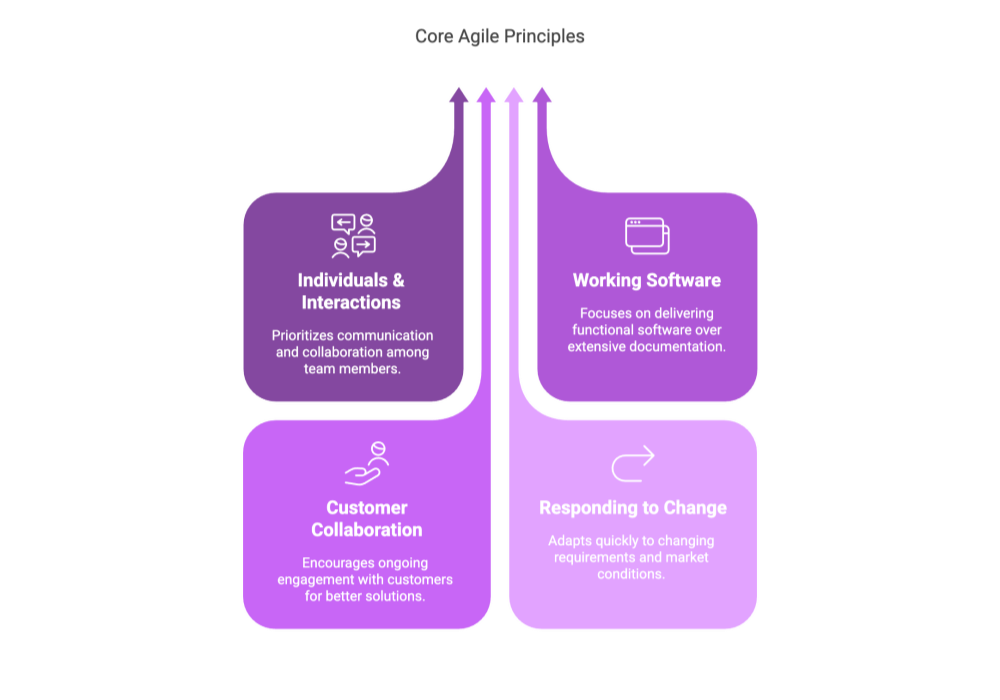

Why Agile vs. Traditional Waterfall?
Agile offers several clear advantages over the traditional waterfall model, which typically involves a linear and sequential approach to software development. In contrast, Agile focuses on iterative progress and continuous feedback, which allows teams to address issues as they arise and adapt to changes rapidly. This results in software that is more aligned with user needs and market dynamics.
Some key benefits of Agile over waterfall include:
- Continuous Feedback: Regular inspections and reviews allow teams to identify and fix issues early in the development cycle.
- Flexibility: Agile welcomes changing requirements, enabling teams to integrate new insights and adjust priorities without disrupting the entire project.
- Customer-Centricity: With ongoing customer involvement, Agile ensures that the product evolves in line with user expectations and needs.
- Risk Management: Short, iterative cycles reduce the likelihood of catastrophic failures and help teams manage risks more effectively.
This approach not only improves the quality of the final product but also enhances the overall development experience by creating a more responsive and collaborative environment.


Agile Software Development Lifecycle
In traditional software development, the process is divided into distinct phases: requirements, design, coding, testing, deployment, and maintenance. Agile transforms this process into overlapping, recurring cycles that promote continuous improvement. The Agile lifecycle typically includes the following stages:
- Planning: The team reviews the product backlog to decide which tasks or features will be addressed in the upcoming Sprint.
- Design and Architecture: Developers and designers collaborate on the best way to implement the selected features, discussing technical approaches and system architecture.
- Implementation: The team writes code and integrates new functionality, while also addressing any necessary bug fixes within the Sprint.
- Testing: Quality assurance, either through dedicated testers or within the development team, verifies that new features work as intended and integrate seamlessly with existing components.
- Review: At the end of the Sprint, a demo or review session is held where stakeholders provide feedback on the latest increment of working software.
- Retrospective: The team reflects on the Sprint to identify successes and areas for improvement, setting the stage for the next cycle.
This iterative process repeats until the product meets all stakeholder requirements or the backlog is fully addressed. The cyclical nature of Agile ensures that each iteration builds on the last, driving continuous improvement and innovation.
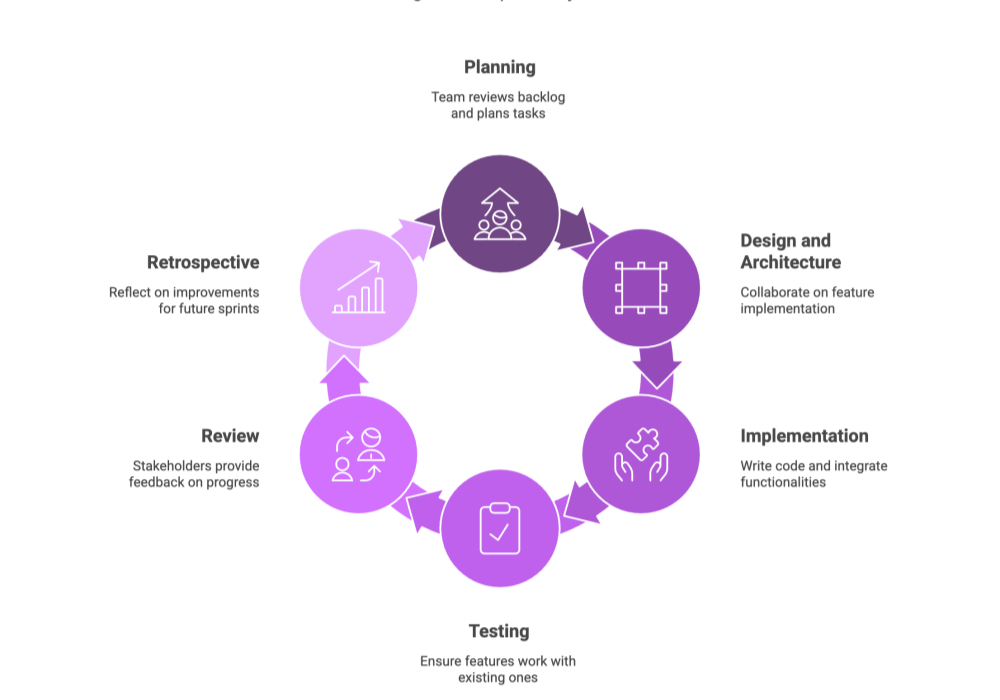

Key Agile Methodologies
Agile software development methods share core iterative principles but differ in the details of implementation. Two of the most popular methodologies are Scrum and Kanban, each offering distinct approaches to organizing work.
Scrum in Agile Software Development
Scrum is widely recognized for structuring work around small, cross-functional teams that operate in fixed-length Sprints, typically lasting two to four weeks. In Scrum, specific roles are defined: the Product Owner manages a prioritized backlog, the Scrum Master facilitates daily meetings and ensures adherence to Scrum practices, and the Development Team self-organizes to complete tasks within each Sprint. This framework breaks down complex projects into manageable increments, fostering transparency and accountability throughout the process.
What is Scrum in Agile Software Development?
Scrum is essentially a subset of Agile that employs timeboxed Sprints and daily stand-ups. At the conclusion of each Sprint, the team demonstrates new functionalities, gathers feedback, and adjusts its plans for the next iteration. This regular review process helps ensure that the project remains aligned with user needs and market changes.
Kanban
Kanban focuses on visualizing work and limiting work in progress (WIP). Teams use a board—either physical or digital—with columns labeled “To Do,” “Doing,” and “Done.” By setting WIP limits, Kanban helps prevent bottlenecks and maintains a smooth workflow. Unlike Scrum, Kanban does not rely on fixed-length Sprints; instead, tasks are continuously pulled into the workflow as capacity becomes available, making it ideal for environments where priorities frequently shift.
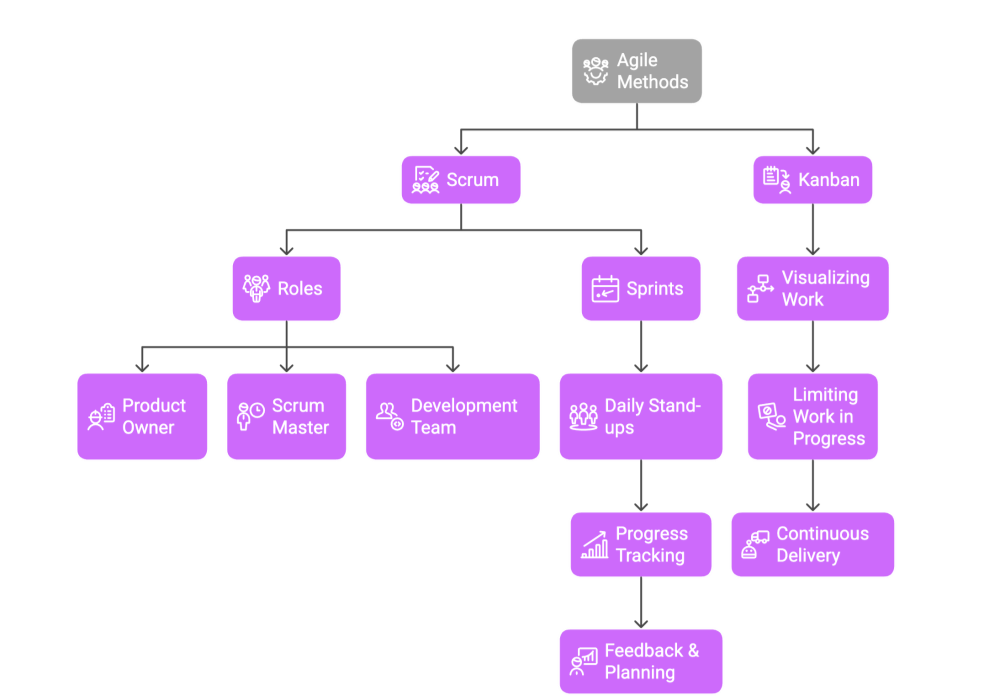

Tools Used in Agile Software Development
Agile teams rely on a variety of tools to streamline their iterative processes and enhance collaboration. These tools support everything from backlog management to version control and continuous integration. Some commonly used tools include:
- Jira: A robust platform for managing user stories, tasks, and Sprints.
- Trello: A simple Kanban board that is ideal for smaller teams or projects.
- GitHub or GitLab: Essential for managing pull requests (PRs), code reviews, and version control.
- Azure DevOps: An integrated solution offering boards, repositories, and pipelines to manage the entire development lifecycle.
- Additional tools such as Slack for communication and Confluence for documentation further support Agile workflows.
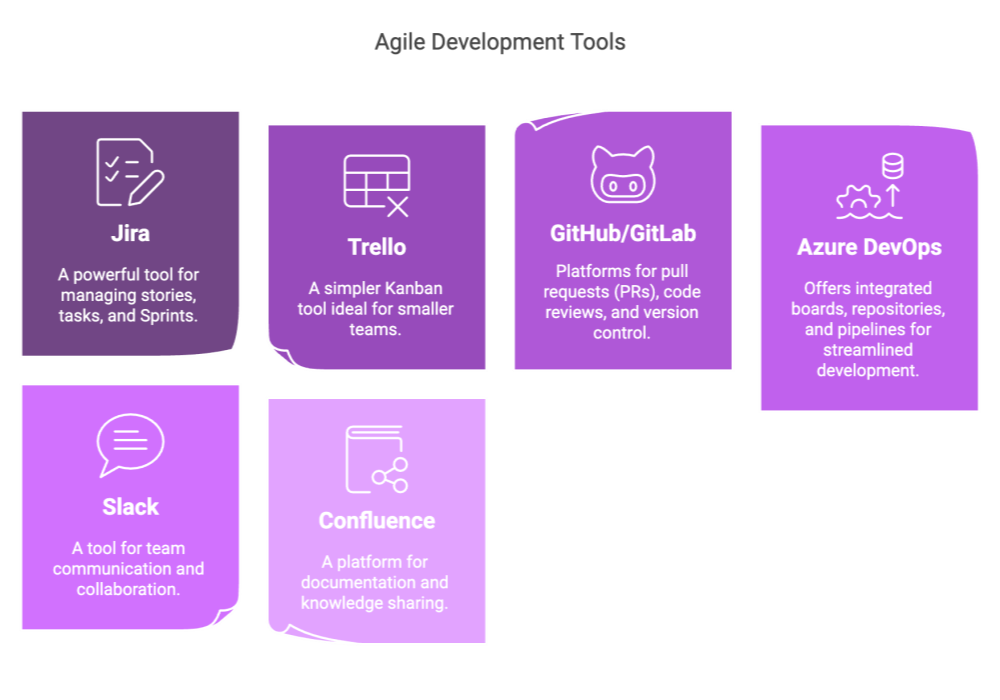

The Role of Quality Assurance and Testing
Quality assurance (QA) is essential for maintaining a high standard of software quality in an Agile environment. Even when developers follow best practices, subtle bugs, regressions, or performance bottlenecks can occur. QA testers or engineers design test cases and execute them to ensure that each new feature meets its functional requirements and integrates smoothly with the existing system. This continuous verification is crucial for delivering reliable software and helps to reduce costly post-release fixes.
By incorporating automated testing frameworks and integrating them into the development pipeline, teams can quickly identify and address issues. This proactive approach not only improves product quality but also fosters a culture of accountability, where every team member is committed to delivering a robust product.
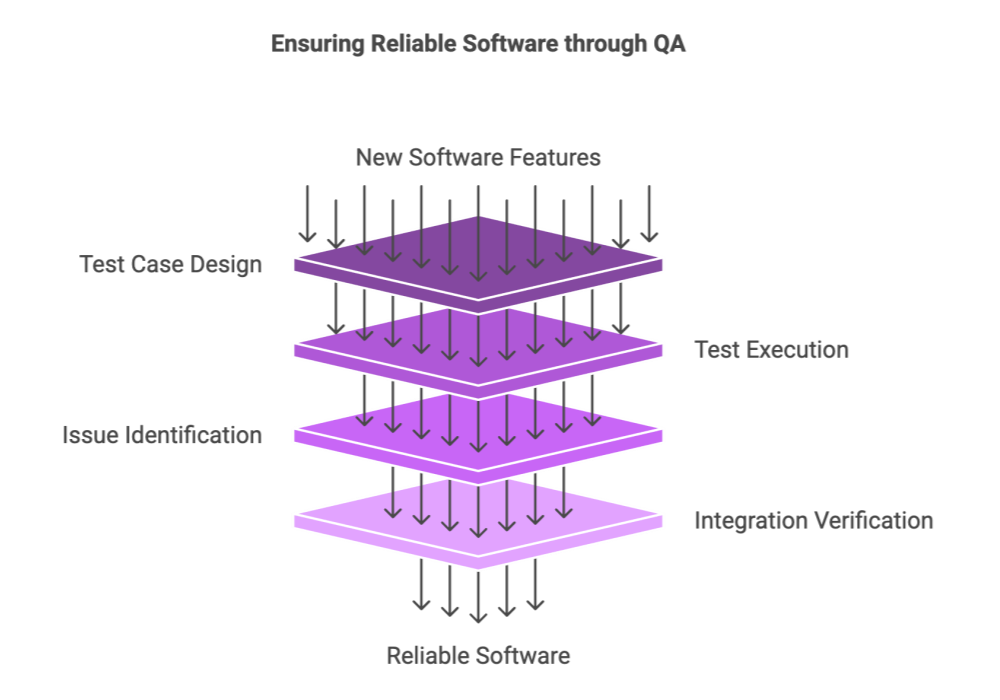

Integrating QA in Agile
Modern Agile teams integrate QA as an integral part of the development process rather than treating it as a separate phase. Testing is carried out concurrently with development, and automated test suites are run with every code commit. This integrated approach ensures that quality is built into the product from the start and helps catch issues early, reducing the need for extensive rework later.
Collaboration between developers and QA professionals is key; when everyone shares responsibility for quality, the entire team is more vigilant and proactive in identifying and resolving issues. This leads to faster delivery times and more consistent product performance.
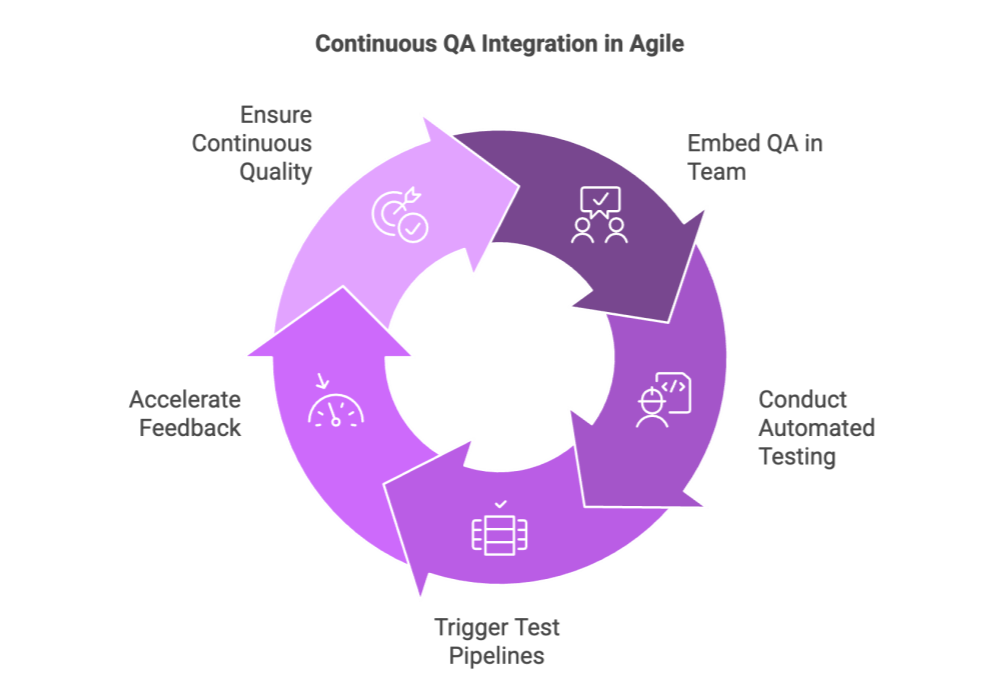

Overcoming Common Agile Challenges
While Agile offers significant benefits, it is not without its challenges. Shifting requirements, technical debt, and coordination across multiple teams can complicate the development process, especially in large organizations. Agile methodologies address these challenges by emphasizing iterative reviews, frequent feedback, and continuous improvement. However, achieving success with Agile requires strict discipline, clear communication, and a commitment to maintaining a clean and prioritized backlog.
Teams must be prepared to adapt quickly when priorities change and to regularly assess and refine their processes to prevent bottlenecks and inefficiencies. This ongoing commitment to improvement is what ultimately drives the success of Agile in dynamic development environments.
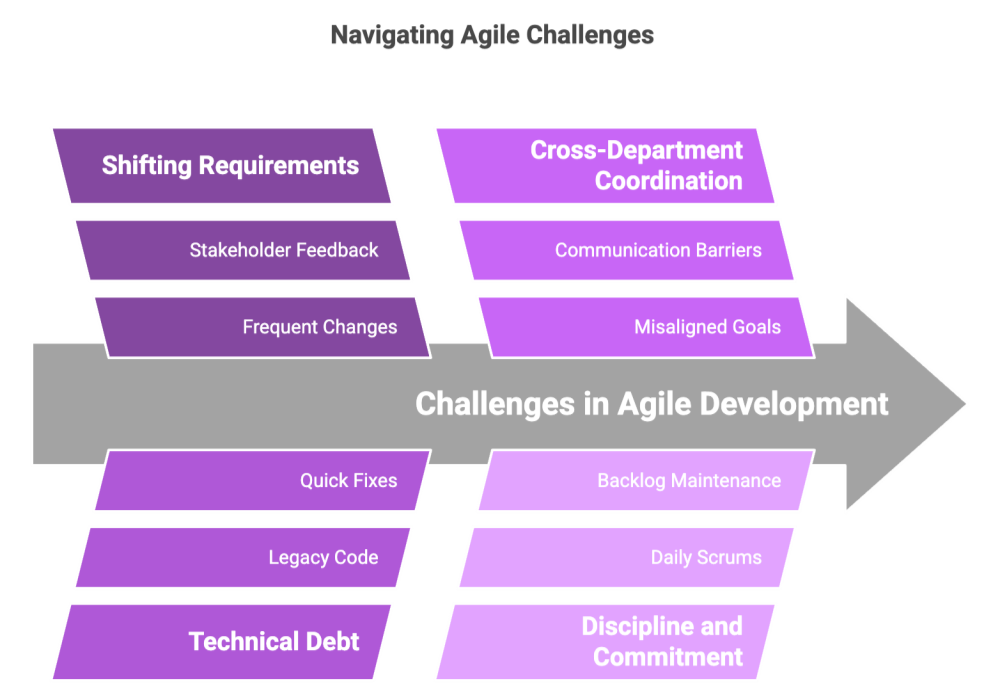

How to Learn Software Development?
Many developers acquire coding skills through online tutorials, bootcamps, or academic programs. They then complement this foundational knowledge with Agile methodologies, which emphasize iterative learning and real-world practice. By engaging in hands-on projects and sprints, developers build tangible skills and gain practical experience that prepares them for the fast-paced demands of modern software development. This combination of theoretical learning and practical application is critical for mastering both the technical and process-oriented aspects of Agile development.
Furthermore, learning Agile is not just about coding; it involves understanding team dynamics, effective communication, and continuous improvement. Developers who embrace these principles are better equipped to contribute to projects in a way that maximizes efficiency and quality.
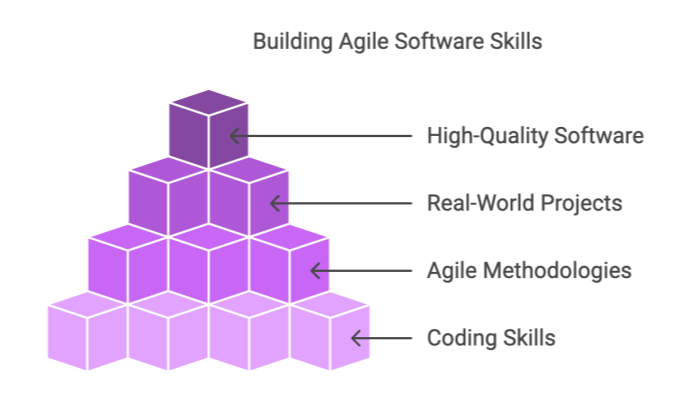

What Is POC in Software Development?
A “proof of concept” (POC) is a small exercise designed to validate a particular idea, technology stack, or design approach. In Agile, teams frequently develop POCs to test feasibility before committing to full-scale implementation.
This approach helps ensure that resources are not wasted on unproven ideas and that potential pitfalls are identified early in the development process. By validating key assumptions early, POCs help guide decision-making and reduce the risk of costly errors later on.
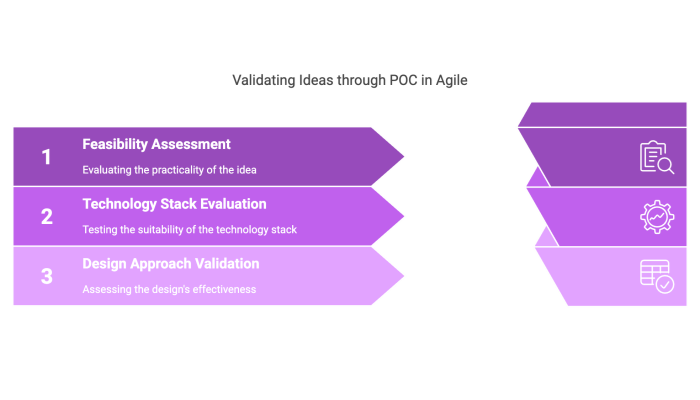

Collaboration and Communication in Agile Teams
Agile emphasizes continuous collaboration among developers, testers, and business stakeholders. Daily stand-ups, sprint reviews, and retrospectives create a structured environment where team members can exchange ideas, discuss challenges, and align on priorities. This regular interaction not only improves transparency but also ensures that the final product is closely aligned with user needs and expectations. Effective communication is the cornerstone of Agile, as it drives better decision-making and fosters a culture of shared accountability.
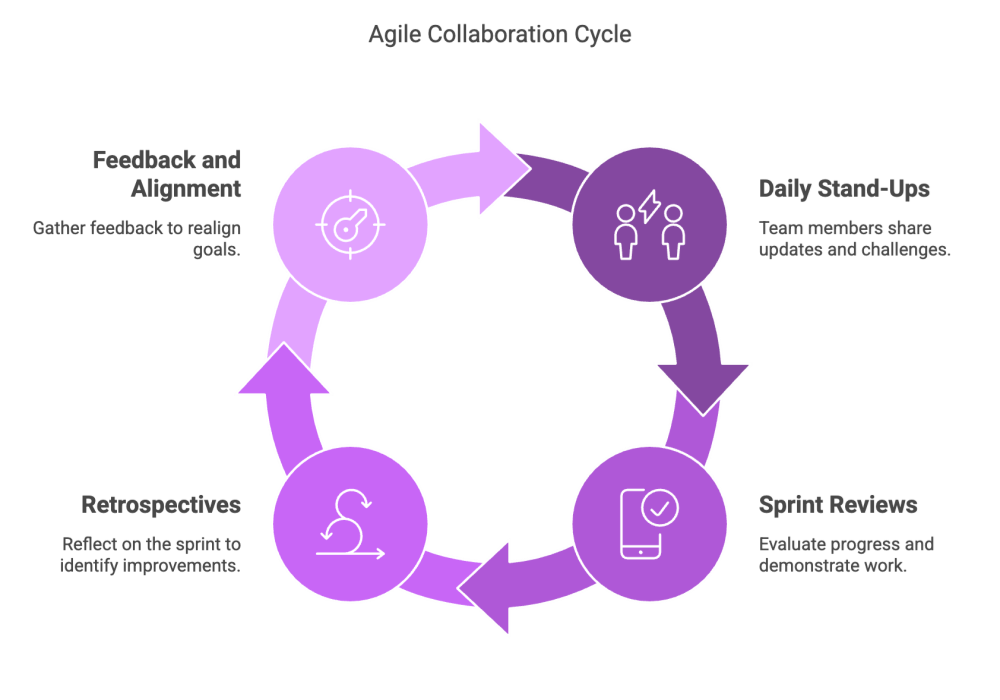

What Is PR in Software Development?
In modern development practices, “PR” stands for “pull request.” It is a mechanism where a developer proposes changes to the codebase, which are then reviewed by peers. This process involves commenting on the proposed changes, suggesting modifications, and ultimately approving or rejecting the updates. The pull request process ensures that all code changes are thoroughly vetted before integration, thereby maintaining high standards of code quality and fostering a culture of collaboration among team members.
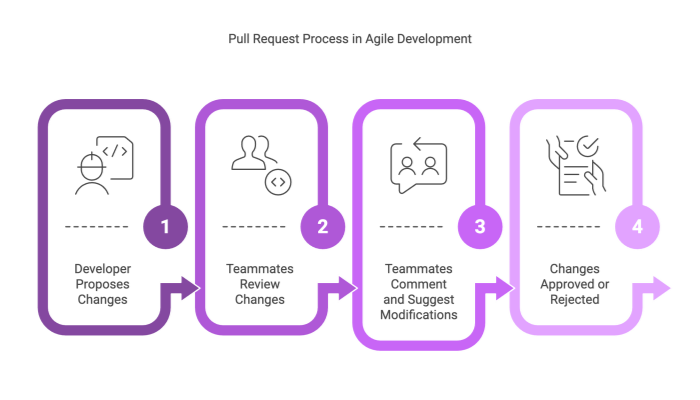

Aligning Stakeholders with Iterative Feedback
Agile encourages continuous collaboration not only among developers but also with business stakeholders. Regular feedback sessions, such as sprint reviews and retrospectives, ensure that everyone remains informed about the project’s progress and can provide valuable input. This iterative feedback loop helps align expectations, reduces miscommunication, and ultimately drives better outcomes for the product.
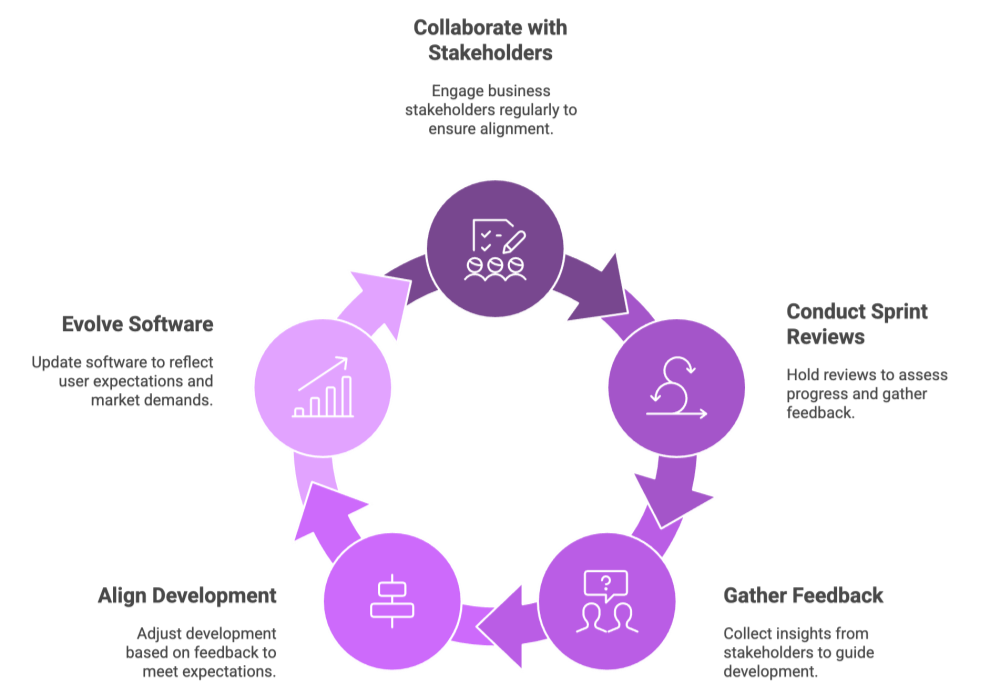

Outsourcing and Distributed Agile Teams
Agile software development can be challenging when teams are distributed across different time zones or cultural environments. However, many organizations have successfully implemented Agile practices with outsourced or remote teams by leveraging robust collaboration tools, scheduling daily stand-ups that accommodate various regions, and maintaining clear and consistent communication. The key is to ensure that every team member, regardless of location, adheres to the same sprint cycles, backlog grooming sessions, and integration protocols.
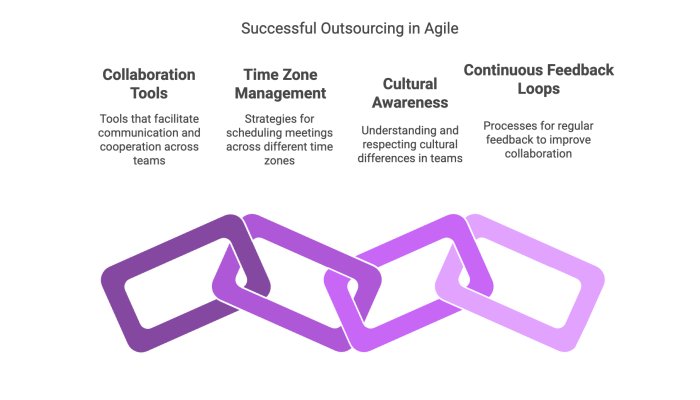

FAQs About Agile and DevOps
Agile and DevOps each focus on shorter cycles and continuous feedback, but in slightly different domains—Agile in development methodology, and DevOps in operational automation and release pipelines. Taken together, they form a robust strategy for delivering features to market faster, reducing waste and errors, and continuously aligning products with user expectations. By adopting flexible frameworks, embedding security, tracking meaningful metrics, and choosing the right approach for your organization’s size and culture, you can see significant gains in both team productivity and end-user satisfaction.
1. How Does Agile Relate to DevOps?
Agile focuses on iterative, collaborative development, breaking projects into small increments and continuously adapting requirements. DevOps complements Agile by emphasizing automation, continuous integration (CI), and continuous delivery (CD) for swift and reliable software releases. When combined, Agile and DevOps form a seamless approach from development to deployment, reducing handoff delays and enhancing product quality.
2. Is Agile Only for Software?:
Although Agile began in software development, organizations have successfully applied its principles to hardware engineering, digital marketing, product design, and other areas that benefit from rapid feedback and adaptive planning. The key is to focus on iterative progress, collaborative teams, and customer-centric outcomes regardless of the specific domain.
3. What Are the Core Principles of Agile?
Agile is built on four core values and twelve principles that highlight people over processes, working software over comprehensive documentation, stakeholder collaboration over contracts, and an openness to change over rigid plans. This results in frequent delivery of value, self-organizing teams, continuous improvement, and strong customer involvement throughout the project.
4. Do We Need Separate Teams for Agile and DevOps?
Not necessarily. Agile teams often focus on development and iteration, while DevOps brings operations and development together to maintain automated pipelines and infrastructure. Some organizations have separate DevOps specialists; others incorporate DevOps practices directly within the same cross-functional Agile teams. The structure depends on your project’s complexity, technology stack, and organizational culture.
5. Can DevOps Work Without Agile?
Yes, technically DevOps can exist in less iterative environments; however, DevOps flourishes when teams adopt shorter release cycles and quick feedback loops—key traits of Agile. Without Agile’s collaborative and flexible mindset, DevOps culture (automation, rapid iteration, continuous delivery) can be harder to sustain effectively.
6. Which Agile Framework Works Best with DevOps?
Scrum, Kanban, and Lean can all blend effectively with DevOps. Scrum’s sprint-based cycles pair well with continuous integration, while Kanban’s focus on limiting work-in-progress can streamline DevOps pipelines. The choice depends on your team’s project size, complexity, and collaborative style.
7. How Do Agile and DevOps Address Security?
Agile ensures early engagement with security requirements, repeatedly integrating feedback from security teams or automated scanning tools. DevOps extends this by embedding security checks—often referred to as DevSecOps—into the CI/CD pipeline, automating vulnerability scanning, code analysis, and compliance checks throughout the development lifecycle.
8. What Metrics Indicate Agile and DevOps Success?
Common performance indicators include:
Lead Time: How quickly a feature moves from idea to production.
Deployment Frequency: How often code reaches production.
Mean Time To Recovery (MTTR): The time needed to restore service after incidents.
User Feedback Cycle: The speed of capturing and acting on stakeholder or end-user input. Improving these metrics suggests your Agile-DevOps pipeline is delivering faster and safer releases.
9. Is Agile Viable for Large-Scale or Distributed Projects?
Yes. Agile frameworks like SAFe (Scaled Agile Framework) or Large-Scale Scrum (LeSS) are specifically designed to extend Agile practices across multiple teams, departments, or even entire enterprises. By coordinating sprint schedules, sharing consistent product goals, and communicating frequently, large organizations can maintain agility and alignment even in distributed settings.
10. How Do I Start Transitioning from Waterfall to Agile DevOps?
Begin by identifying pilot projects or smaller teams that can adopt short sprints, daily stand-ups, and automated deployments. Provide training on Agile principles and DevOps tooling (CI/CD). Gradually scale successful practices across the organization, adjusting roles, processes, and governance structures as necessary. Frequent retrospectives ensure teams learn and refine their combined Agile-DevOps approach at each iteration.
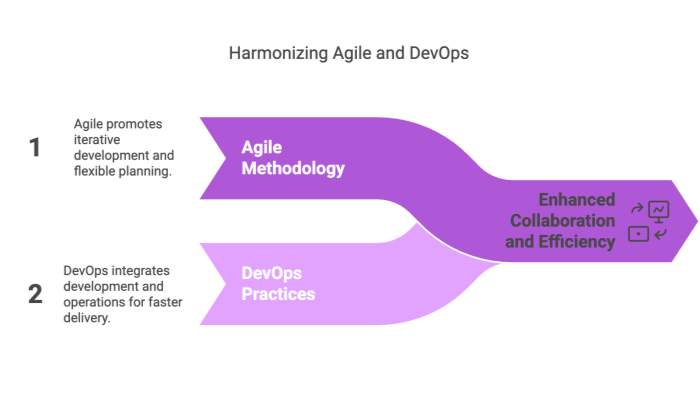

Taking Agile to the Next Level
Agile reorients traditional methodologies around iterative, user-centric progress. Beyond accelerating development cycles, Agile establishes a robust feedback loop between product teams and customers, ensuring continuous improvement and rapid adaptation to market changes. By adopting frameworks such as Scrum or Kanban, integrating automated testing, and fostering a culture of transparency, organizations can elevate their Agile practices to deliver even greater value.
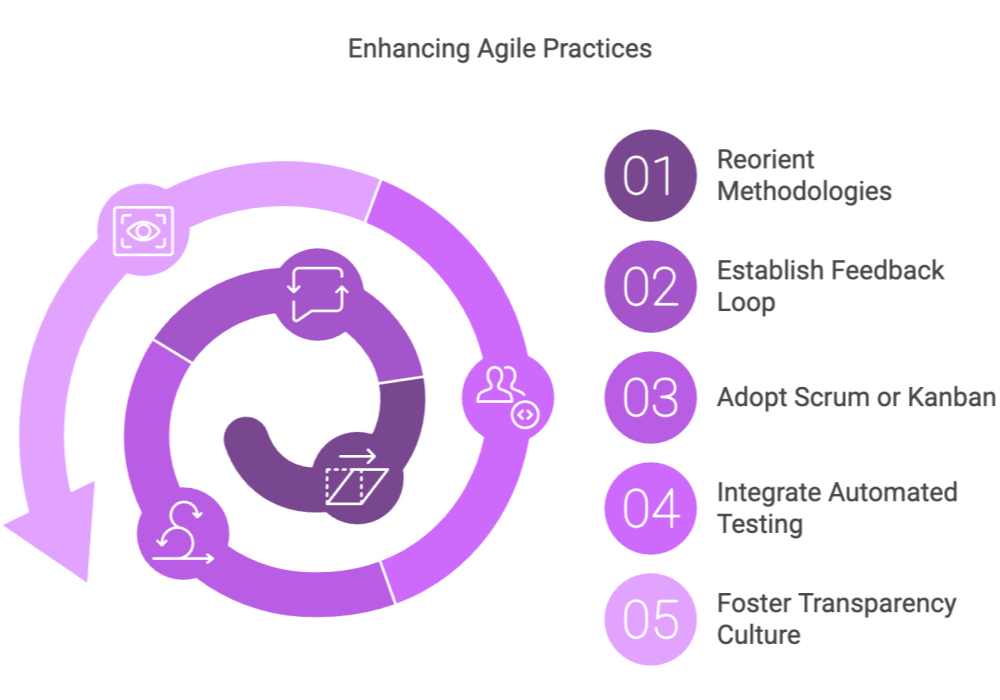

Emphasizing Continuous Improvement
Agile thrives on frequent reflection—teams continuously ask what worked, what did not, and how processes can be refined. This culture of continuous improvement not only drives better product quality and efficiency but also helps teams adapt to new challenges. Incremental enhancements over time lead to significant gains in productivity, code quality, and stakeholder satisfaction, ensuring that the development process remains dynamic and responsive.
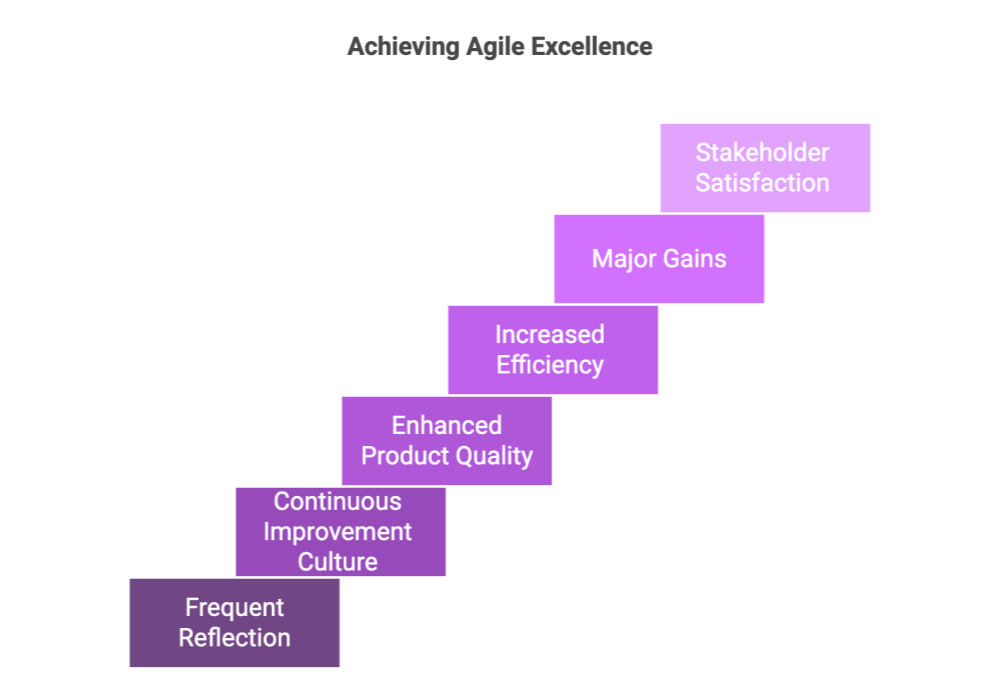

Conclusion
Agile software development reorients traditional methodologies around iterative, user-centric progress. From short sprints and daily stand-ups to integrated QA and continuous feedback, Agile enables teams to maintain flexible workflows without sacrificing quality. By fostering collaboration among product owners, developers, testers, and stakeholders, Agile addresses many of the shortcomings found in rigid, linear approaches.
For teams new to Agile, adopting frameworks like Scrum or Kanban, establishing consistent testing practices, and cultivating a culture of continuous improvement can significantly boost productivity. Moreover, integrating automated tools for version control, backlog management, and deployment can enhance overall team synergy. Ultimately, Agile is not just about speeding up software delivery—it’s about creating a responsive, evolving process that consistently delivers value and meets genuine customer needs.

Reach Cognativ Today.
At Cognative, our guiding principle is simple but powerful: “Putting you back in control.” Whether you’re a startup refining your product roadmap, an established business expanding into new markets, or a forward-thinking organization seeking modern solutions, we help you craft software that’s secure, scalable, and elegantly tailored to your unique needs.
If you’re looking for a collaborative, results-focused partner in software development – or simply want to explore ideas for an upcoming project – we’re here to assist. Our experts bring in-depth technical knowledge, genuine insight into your business context, and a commitment to quality in every aspect of the development lifecycle.
Ready to take the next step?
Consult with Our Team: Let’s discuss your challenges and discover how a custom-built or modernized solution can save time, reduce costs, and enhance overall performance.
Bring Your Vision to Life: We thrive on translating concepts into tangible products, starting with MVPs to iterating and refining, ensuring that your voice remains at the heart of the development process.
Experience Full Transparency and Control: Our approach keeps you informed at each phase, preserving creative control so you’re always confident in the product’s direction, design, and final outcome.